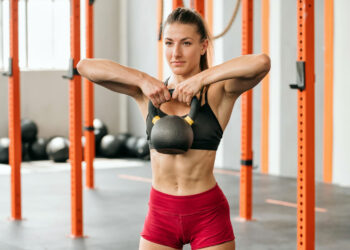No one is really sure how the Turkish Get Up got its name. It’s not especially well-known in Turkey, and you don’t look much like a turkey when you are doing it! It may be linked to Turkish wrestlers, famed for their strength and agility, but this is not a proven fact.
However, what we do know about this exercise is that doing it properly and regularly will have a big impact on how you look, feel, and perform. In this article, you will learn why and how to master Turkish get up.
Muscles worked during the Turkish Get Up
On seeing this exercise, a lot of people want to know what muscles are being worked. This is not an easy question to answer! Turkish get-ups involve virtually every muscle in your body, from your legs to your core to your shoulders. The main muscles you’ll feel working during Turkish get-ups are:
- Deltoids – every stage of the Turkish get up involves a lot of shoulder stability (1). You have to work very hard to keep your arm vertical as you move your body from the floor to standing. This provides your shoulders or deltoids with an excellent workout.
- Core – the collective term for the muscles of your midsection, Turkish get ups require a lot of core strength. This exercise works all of your core muscles, including your rectus abdominus, obliques, erector spinae, and transverse abdominus.
- Gluteus maximus – the large muscle on the back of your hip, your glutes are your main hip extender. Get ups involve lifting your hips off the floor and getting into a bridge position. This requires a lot of glute activation.
- Hamstrings – working alongside your glutes, your hamstrings also extend your hip.
- Quadriceps – the muscles on the front of your thighs, your quads extend your knee. You’ll feel your quads working as you stand up at the end of each rep.
How to do Turkish get ups
Let’s get this straight from the start – Turkish get ups are a very complex exercise. It involves a lot of different movements, and it requires a lot of coordination. You’ll also need excellent mobility, flexibility, stability, and strength to do it.
Because of this, take your time learning this exercise, and don’t use too much weight too soon. And don’t worry if, at first, you keep getting it wrong. With practice, you CAN master the Turkish get up. Once everything “clicks,” you’ll really start seeing all the benefits this exercise has to offer.
1- Holding a kettlebell or dumbbell in one hand, lie on your back with your arm straight. Push the weight straight up toward the ceiling, so your arm is vertical. Look up at the weight and keep your eyes fixed on it through the whole exercise.
Level Up Your Fitness: Join our 💪 strong community in Fitness Volt Newsletter. Get daily inspiration, expert-backed workouts, nutrition tips, the latest in strength sports, and the support you need to reach your goals. Subscribe for free!
2- Bend your leg and place your foot flat on the floor. If you are holding the weight in your left hand, bend your left leg. If you’re using your right arm, bend your right leg. Extend your opposite arm out to the side at 90-degrees to your body.
3– Brace your abs and drive your foot into the floor. Sit up partway and push the weight up toward the ceiling. Simultaneously roll across onto the opposite forearm. Make sure you keep your weight-bearing arm vertical.
4– Push your forearm away from the floor so that your arm is straight, and your palm is flat on the ground. You should now be sat close to upright with one leg bent, and the other leg extended.
5– Push your foot into the floor again and lift your hips off the floor. Keep your uppermost arm straight, and your eyes fixed on the weight. This position should resemble a sort of side plank with your uppermost arm extended toward the ceiling.
6– With your hips up, pull your straight leg under you and into a half-kneeling lunge. Your supporting hand should still be on the ground. Push off with your hand and move your torso into an upright position with your arm extended above your head.
7– Stand up so that your feet are together. Your weight-bearing arm should be vertical.
8– Return to the starting position by doing the same movement in reverse. Step back into a lunge, lower your rear knee to the floor, lean down and place your hand flat on the floor, swing your rear leg out in front of you, drop your butt to the floor, roll down onto your forearm, and then lie down flat on your back.
If you are struggling to master this exercise, try doing it without any weight. With no dumbbell or kettlebell to worry about, you’ll be free to focus on the mechanics of the movement. When you can do get ups comfortably and smoothly without weight, grab a light kettlebell or dumbbell to make it a bit more challenging. Increase the weight only when you feel confident to do so.
The benefits of Turkish get ups
There is no getting away from it, Turkish get ups can be tricky and time-consuming to master. But, if you practice and persevere, they offer a wide range of benefits.
The main benefits of get ups are:
Great for mobility and flexibility– Turkish get ups have a yoga-like quality about them. They involve large movements that stretch many different muscles. If you find static stretching boring, Turkish get ups could be the flexibility exercise you have been waiting for.
Increased stability– if you wobble when doing Turkish get ups, the weight could come crashing down on your head. Not good! Holding the weight steady while you move from the floor to standing upright will develop stability, especially in your hips, core, and shoulders. Increased stability is useful for reducing your risk of injury and can increase sports performance too.
Core recruitment– Turkish get ups involve a lot of core work. The initial sit-up targets your rectus abdominus, while the roll onto your side works your obliques. Your core also works isometrically to keep your spine stable as you move from one position to another. Get ups work every muscle in your midsection.
Improved coordination and balance– Turkish get ups are very technical and require a lot of coordination and balance to do correctly. With practice, you’ll not only master this complex movement, but you’ll find other difficult movements easier.
Great for cardio and calorie burning– this exercise works so many muscles at the same time that you’ll soon notice your heart and breathing rate start to rise. Comparable to other full-body exercises like burpees and power cleans, Turkish get ups can help you get fit and lose weight while making you stronger.
Turkish get up variations
Mastered the Turkish get up already? Here are a few variations to try.
Sandbag Turkish get up
Using a sandbag makes get ups much harder. The weight shifts as you move, which increases core activation. You’ll have to work much harder to keep the load stable. You can do this exercise with the sandbag held up above your head, or with it resting on your shoulder.
Barbell Turkish get ups
This advanced exercise will really test your balance. The barbell will tilt if you don’t keep your arm vertical. You’ll have to pay extra attention to your technique if you try this variation. Hold the barbell in the middle to give you the best chance of success.
Two-handed Turkish get up
With this variation, you either hold one weight with both hands or a weight in each hand. Either way, without your arms to help you stand up, this exercise is very challenging.
Wrap up
The Turkish get up is a crazy-looking exercise, but it’s also one with a long list of benefits. Done with a dumbbell, kettlebell, sandbag, or barbell, it works virtually every muscle in your body and will build strength, coordination, and mobility, all at the same time. Whether you want to build muscle, lose fat, improve your athleticism, or get fit, adding Turkish get ups to your workouts will help you reach your goal faster.
References:
1. PubMed: St-Onge, Eric; Robb, Andrew; Beach, Tyson A. C.; Howarth, Samuel J. (2019-01). “A descriptive analysis of shoulder muscle activities during individual stages of the Turkish Get-Up exercise”. Journal of Bodywork and Movement Therapies. 23 (1): 23–31. doi:10.1016/j.jbmt.2018.01.013. ISSN 1532-9283. PMID 30691756. https://www.ncbi.nlm.nih.gov/pubmed/30691756








